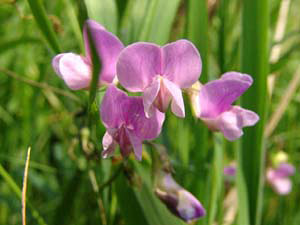Relatives
Lathyrus palustris L. - Boggy grass pea.
Taxonomic position.
Family Fabaceae Lindl., genus Lathyrus L.Morphology and biology.
Perennial plant, 40-100 cm in height, with a thin, branchy, creeping root. Stem is bare, branchy, ascending. Stipules are small, semi-sagittate, 4-15 mm in length, 1-4 mm in width. Leaves usually consist of 4 (less often 3-5) pairs of oblong or lanceolate leaflets with 3-5 sections, 3-6 cm in length, 2-15 mm in width. The leaf axis culminates in a simple or branchy, short tendril. Racemes are as long as the leaves and have 2-6 flowers. Flowers are drooping, with a weak fragrance, 16-18 mm in length. Pedicels are slightly shorter than the calyx. Calyx is campanulate; calyx denticles are triangular, with short, ciliate pubescence. Bottom denticle length is the same as that of the tube; top denticle length is 3 times shorter than that of the tube. Corolla is blue-lilac. Flag is round-oval, with dredging on top, on wide stem. Wings are pale lilac, on long, bent stem. Keel is wide and lanceolate, rounded on the bottom edge. Pods are linear-lanceolate, compressed from the sides, 40-60 mm in length, 6-10 mm in width. Valves of pods have oblique-mesh veins. Seeds are compressed, smooth, red-brown; there are 6-12 seeds in a pod. Hilum length is equal to 1/4 the circumference of the seed. Chromosome number: 2n=14. Blossoms in July; fructifies in August.Distribution.
The general distribution area includes Scandinavia, Atlantic Europe, the Mediterranean, and the Balkansky-Maloaziatsky and Dzhungarsko-Kashgarsky areas. Within the former USSR, the species is distributed throughout the entire European part (except for the Lower Volga and Crimea), the Caucasus, Ciscaucasia, all of Western Siberia, Eastern Siberia (Yenisei and Angaro-Sajansky areas), and Central Asia (Pribalhashsky area).Ecology.
It grows in crude meadows, among bushes, and in meadow sedge-reed bogs.Use and economic value.
This is a fodder plant of average advantage; it is of great importance in crude places since it grows well under conditions of excessive humidity. In pastures, it is eaten only by large, horned livestock; in the form of hay, it is also eaten by horses.References:
Cherepanov, S.K. 1995. Plantae Vasculares Rossicae et Civitatum Collimitanearum (in limicis USSR olim). St. Petersburg, Mir I Semia, 990 p. (in Russian).Hulten E., Fries M. 1986. Atlas of Northern European Vascular Plants North of the Tropic of Cancer. Vol. 1-3. Koeltz Scientific Books, Konigstein.
Grossgeim, A.A. 1952. Flora of the Caucasus. Vol. 5. Moscow-Leningrad: Publishing House of the USSR Academy of Sciences, 424 p. (in Russian).
Kharkevich S.S., ed. 1989. Vascular plants of the Soviet Far East. Vol. 4. Leningrad: Nauka, 380 p. (in Russian).
Moesel, H. 1965. Vergleichende Chorologie der Zentraleuropischen Flora. Jena, 583 p. (in German).
Shishkin B.K., ed. 1958. Flora of the USSR. Vol. 23. M.-L.: Publishing House of Acad. Science, pp. 524-525. (in Russian).
Tolmachev A.I., ed. 1976. Flora of the Northeastern European Part of the USSR. Vol. 3. Leningrad: Nauka, 293 p. (in Russian).
Tsvelev, N.N. 2000. Manual of the Vascular Plants of Northwestern Russia (Leningrad, Pskov and Novgorod district). St. Petersburg, Publishing House of SPHFA, p. 511. (in Russian).
© T.N. Smekalova


